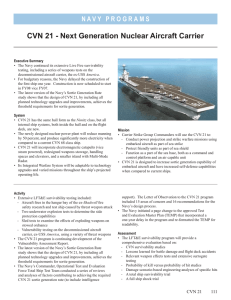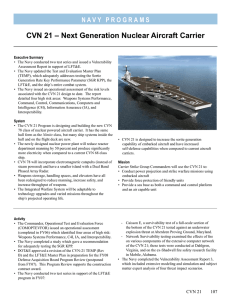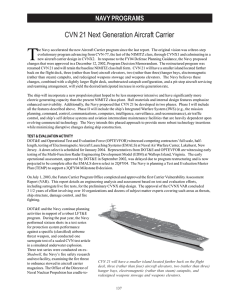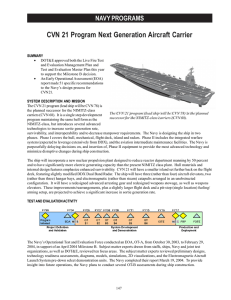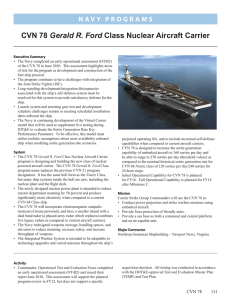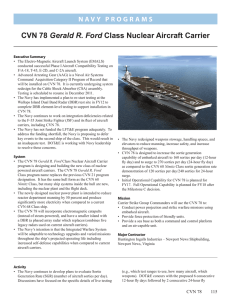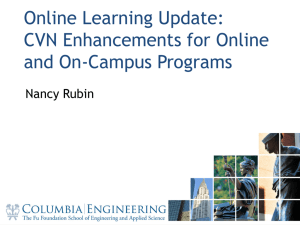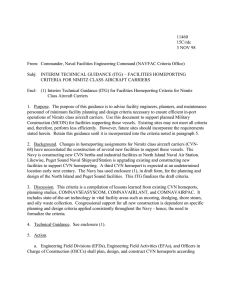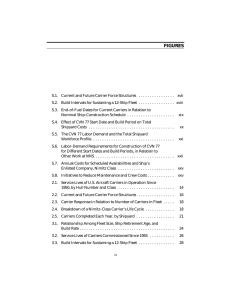CVN 21 – Next Generation Nuclear Aircraft Carrier
advertisement
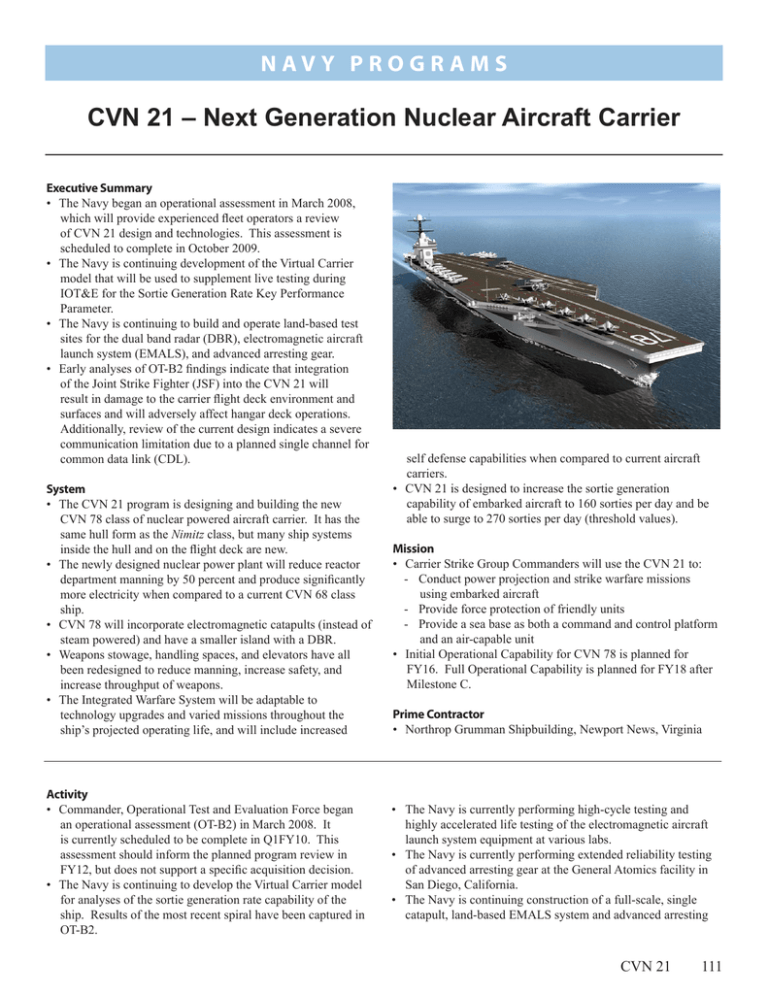
N a v y P ROGRA M S CVN 21 – Next Generation Nuclear Aircraft Carrier Executive Summary • The Navy began an operational assessment in March 2008, which will provide experienced fleet operators a review of CVN 21 design and technologies. This assessment is scheduled to complete in October 2009. • The Navy is continuing development of the Virtual Carrier model that will be used to supplement live testing during IOT&E for the Sortie Generation Rate Key Performance Parameter. • The Navy is continuing to build and operate land-based test sites for the dual band radar (DBR), electromagnetic aircraft launch system (EMALS), and advanced arresting gear. • Early analyses of OT-B2 findings indicate that integration of the Joint Strike Fighter (JSF) into the CVN 21 will result in damage to the carrier flight deck environment and surfaces and will adversely affect hangar deck operations. Additionally, review of the current design indicates a severe communication limitation due to a planned single channel for common data link (CDL). System • The CVN 21 program is designing and building the new CVN 78 class of nuclear powered aircraft carrier. It has the same hull form as the Nimitz class, but many ship systems inside the hull and on the flight deck are new. • The newly designed nuclear power plant will reduce reactor department manning by 50 percent and produce significantly more electricity when compared to a current CVN 68 class ship. • CVN 78 will incorporate electromagnetic catapults (instead of steam powered) and have a smaller island with a DBR. • Weapons stowage, handling spaces, and elevators have all been redesigned to reduce manning, increase safety, and increase throughput of weapons. • The Integrated Warfare System will be adaptable to technology upgrades and varied missions throughout the ship’s projected operating life, and will include increased Activity • Commander, Operational Test and Evaluation Force began an operational assessment (OT-B2) in March 2008. It is currently scheduled to be complete in Q1FY10. This assessment should inform the planned program review in FY12, but does not support a specific acquisition decision. • The Navy is continuing to develop the Virtual Carrier model for analyses of the sortie generation rate capability of the ship. Results of the most recent spiral have been captured in OT-B2. self defense capabilities when compared to current aircraft carriers. • CVN 21 is designed to increase the sortie generation capability of embarked aircraft to 160 sorties per day and be able to surge to 270 sorties per day (threshold values). Mission • Carrier Strike Group Commanders will use the CVN 21 to: - Conduct power projection and strike warfare missions using embarked aircraft - Provide force protection of friendly units - Provide a sea base as both a command and control platform and an air-capable unit • Initial Operational Capability for CVN 78 is planned for FY16. Full Operational Capability is planned for FY18 after Milestone C. Prime Contractor • Northrop Grumman Shipbuilding, Newport News, Virginia • The Navy is currently performing high-cycle testing and highly accelerated life testing of the electromagnetic aircraft launch system equipment at various labs. • The Navy is currently performing extended reliability testing of advanced arresting gear at the General Atomics facility in San Diego, California. • The Navy is continuing construction of a full-scale, single catapult, land-based EMALS system and advanced arresting CVN 21 111 N a v y P ROGRA M S gear system at Naval Air Engineering Station Lakehurst, New Jersey. • The Navy has built a land-based test site to continue testing the DBR for both DDG 1000 and CVN 78 ship classes at the Surface Combat Systems Center, Wallops Island, Virginia. • The CVN 21 program is developing an advanced modeling and simulation capability that, combined with reduced scope shock testing of CVN 78, will reduce the cost of conducting the CVN 78 shock trial. The Navy has reached agreement through a Memorandum of Agreement on the elements of the process. DOT&E will withhold its decision to sign the Memorandum of Agreement until FY12 when the feasibility of the modeling and simulation should be demonstrated. • The CVN 21 Program Office is revising the Test and Evaluation Master Plan in an effort to align planned developmental tests with corresponding operational test phases. Assessment • Emerging results from the ongoing OT-B2 Operational Assessment highlight significant integration challenges with the F-35 JSF that will adversely impact mission accomplishment. The most significant integration challenges include: - Hangar Bay space is limited due to the requirement to place JSF Engine Power Modules and JSF Squadron training spaces in the Hangar Bay. - The F-35C thermal footprint from main engine exhaust is larger than legacy aircraft making the Jet Blast Deflectors currently installed on aircraft carriers vulnerable to warping and failure. - Flight deck personnel experience excessive noise levels with JSF engines at full power. 112 CVN 21 - The Integrated Power Pack exhaust from F-35B Short Take-off Vertical Landing variant of the JSF is deflected downward and poses a hazard to flight deck refueling stations, munitions, personnel, and equipment in the catwalks. • Current design has a single transmit/receive channel for CDL. This link is required for effective tactical communication with MH-60R helicopters, P-8A Poseidon Multi-Mission Aircraft, Broad Area Maritime Surveillance, Predator, Firescout, Sky Warrior, Global Hawk, Reaper, and Shadow, as well as other small Tactical Unmanned Aerial Systems. This is a critical limitation especially in a satellite-denied environment. • Stress and environmental testing of advanced arresting gear and EMALS components continues at test sites in both Mississippi and California. These tests have resulted in design changes that are currently under evaluation. The next major electromagnetic aircraft launch system test event scheduled is “dead load” testing (unmanned aircraft size and weight load) in 2QFY10. Testing using manned aircraft is scheduled in FY11. • The planned IOT&E of CVN 78 is planned in conjunction with post delivery sea trials and pre-deployment training. Any delays in ship delivery will jeopardize the dedicated IOT&E period and complete assessment of the ship’s capabilities. Recommendations • Status of Previous Recommendations. The Navy satisfactorily addressed all FY08 recommendations. • FY09 Recommendations. The Navy should: 1. Resolve integration issues with JSF. 2. Resolve CDL limitations. 3. Refine the Test and Evaluation Master Plan to include dedicated IOT&E periods in the ship’s schedule.


